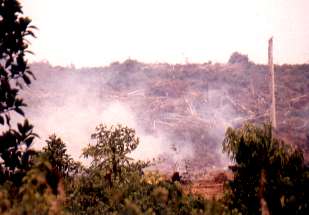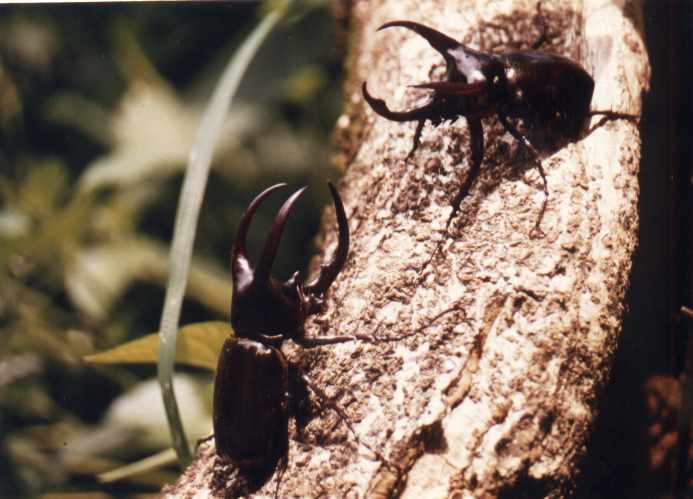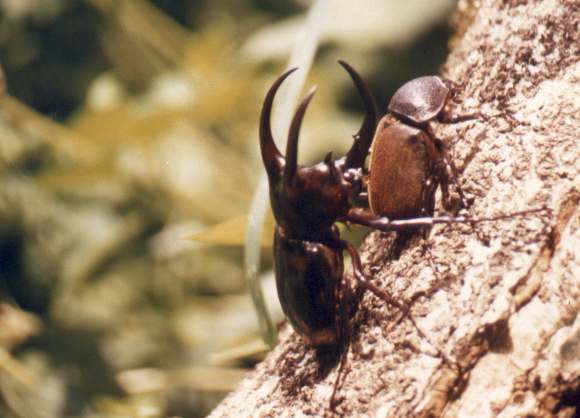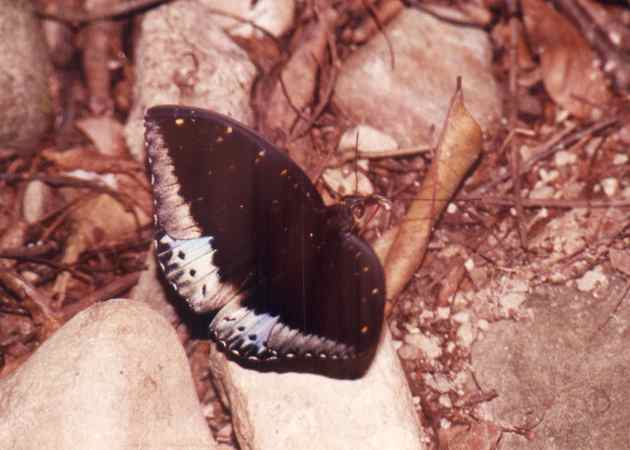Aug. 1, Friday
We arrived at the Sandakan airport in the afternoon. As our bus drove out of the airport, I caught a glimpse of SPOTTED DOVES on the grass and a STORK-BILLED KINGFISHER perched on a wire. We had a Malaysian tour guide, who is a birder and has led previous trips to Sabah. After we checked into Sanbay Hotel by the coast, our guide took us to the temple on the hill behind. Soaring before and above us were dozens of WHITE-BELLIED FISH-EAGLES and BRAHMINY KITES. Then a different raptor alighted on a dead branch. At first sight, we thought it was a Bat Hawk; but our guide disagreed, and upon closer observation, we discovered that it was in fact a RUFOUS-BELLIED EAGLE. On the roof of the temple stood some WHITE-BREASTED WOOD-SWALLOWS, who occasionally took off to harass the eagles. Also darting in the air were BLACK-NEST SWIFTLETS and GLOSSY SWIFTLETS. In the young forest surrounded the temple, we found a pair of ASHY TAILORBIRDS and lots of YELLOW-VENTED BULBULS. In the grass were flocks of BLACK-HEADED MUNIAS mixed with some DUSKY MUNIAS, the first bird we saw endemic to Borneo. Returning to our bus, we saw two SPOTTED DOVES, a WHITE-BREASTED WATERHEN, and at least a dozen PINK-NECKED GREEN-PIGEONS feeding in a bush. A large dove flew by which the guide said was a Mountain Imperial-Pigeon, but I thought it looked more like some kind of green pigeon and did not count it. 15 species already, not bad!
Day total: 15 species
Cumulative total: 15 species
Aug. 2, Saturday
Early in the morning, we headed towards Sepilok Orang-Utan Rehabilitation Centre to bird. We walked the last couple kilometers, looking for birds by the roadside. It was very open habitat, previously burned rainforest with secondary growth, coconut and banana trees growing. There we saw COLLARED KINGFISHERS, SPOTTED DOVES, BLUE-THROATED BEE-EATERS, YELLOW-VENTED BULBULS, BLACK-HEADED MUNIAS, LONG-TAILED PARAKEETS, a fledgling RUSTY-BREASTED CUCKOO, a male SCARLET MINIVET, a DOLLARBIRD, a CHESTNUT-BREASTED MALKOHA, GREY-RUMPED TREESWIFTS, ASIAN GLOSSY STARLINGS, a HILL MYNA, CHESTNUT-RUMPED BABBLERS, a STRIATED HERON, some PIED FANTAILS, and lots of tiny sunbirds and flowerpeckers such as the OLIVE-BACKED SUNBIRDS, CRIMSON SUNBIRD, PLAIN-THROATED SUNBIRDS, YELLOW-RUMPED FLOWERPECKERS, an ORANGE-BELLIED FLOWERPECKER, a SCARLET-BACKED FLOWERPECKER and another unidentified flowerpecker-like bird that was greyish green all over except for bright orange bill and feet. To finish off the list, I happened to spot a male WHITE-BELLIED WOODPECKER while scanning the dead tree branches.
Afterwards, we entered the rainforest in the Sepilok Orang-Utan Rehabilitation Centre, but only saw RED-EYED BULBULS, though there were groups of Pig-tailed and Long-tailed Macaques and a mother Orang-Utan with a young at the feeding platform. Near noon, we birded some more and saw a huge Red Giant Flying Squirrel glide from one tree to another. The only birds we saw were a BROWN BARBET and a couple RAFFLE'S MALCOHAS.
In the afternoon, we went on the same road we came in again. A couple new species were the MAGPIE ROBINS, a pair of SUNDA WOODPECKERS, a RUFOUS PICULET, a LESSER COUCAL, YELLOW-BELLIED PRINIAS, ASHY TAILORBIRDS, PACIFIC SWALLOWS and SILVER-BACKED SWIFTS drinking over a pond, and a female RUBY-CHEEKED FLOWERPECKER. Around dusk, our guide told us to return to the gate of the Orang-Utan Rehab Centre to wait for parakeets to arrive. Surely enough, LONG-TAILED PARAKEETS showed up exactly at the time our guide predicted, though he said that there were far fewer parakeets now than what there used to be.
After dinner, I strolled around looking for nocturnal insects and birds. I only discovered a couple Rhinoceros Beetles Oryctes rhinoceros, a green cicada Dundubia vaginata, katydids, and a small praying mantis. I didn't even hear a single owl or nightjar.
Day total: 44 species
Cumulative total: 46 species
Aug. 3, Sunday
This morning, instead of birding nearby as scheduled, we decided to head to Gomantong Cave to see the swiftlets nesting cave. On the bus, we passed kilometer after kilometer without seeing any sign of virgin forests, only cleared land and palm plantations. This made me wonder whether it was true that much of Borneo was still covered with tropical rainforest.
We finally reached some rainforest only after we entered the gates of
the forest reserve. We got out and birded on the paved road. This was secondary
lowland rainforest, so birding wasn't easy with the the tall trees and
dense foliage. The first birds we saw were a pair of BAT HAWKS in the sky.
At the edge of the forest, we saw PIED FANTAILS, SOOTY-CAPPED BABBLERS,
RED-EYED BULBULS, BLACK-NAPED MONARCHS, a GREATER GREEN LEAFBIRD, a SCARLET-RUMPED
TROGON, a LITTLE SPIDERHUNTER, a female GREY-CHINNED MINIVET (very doubtful),
a pair of WHITE-FRONTED FALCONETS, ASIAN FAIRY-BLUEBIRDS, a RUFOUS PICULET,
LARGE-BILLED CROWS, a WRINKLED HORNBILL, RHINOCEROS HORNBILLS and ORIENTAL
PIED HORNBILLS. Soaring in the sky was a CRESTED GOSHAWK, a STORM'S STORK,
and another unidentified raptor. We even saw a huge Monitor Lizard as we
passed a small stream. In the forest near the entrance of Gomantong Cave,
we saw a male WHITE-BROWED SHAMA, a group of RAFFLE'S MALKOHA, a CHESTNUT-WINGED
BABBLER, and an ORIENTAL HONEY-BUZZARD.  At
Gomantong Cave, there was an astonishing number of BLACK-NEST and EDIBLE-NEST
SWIFTLETS, though almost impossible to distinguish from each other. Their
nests covered the cave walls, shared by an equally astonishing number of
roosting bats. Here, collectors harvested the swiftlets' nests in particular
seasons, protecting the population from over-exploitation. When the nests
are collected, the eggs or young birds must be sacrificed, one reason why
it's inhumane to eat bird nest soup. On the floor of the cave, I discovered
quite a lot of fallen swiftlets that were not able to fly again, though
even now we still couldn't really tell whether they were Black-nest or
the Edible-nest Swiftlets. There was nothing we could do to help these
swiftlets, so we just put them on the wall of the cave hoping that they'll
be able to gain enough strength to fly again.
At
Gomantong Cave, there was an astonishing number of BLACK-NEST and EDIBLE-NEST
SWIFTLETS, though almost impossible to distinguish from each other. Their
nests covered the cave walls, shared by an equally astonishing number of
roosting bats. Here, collectors harvested the swiftlets' nests in particular
seasons, protecting the population from over-exploitation. When the nests
are collected, the eggs or young birds must be sacrificed, one reason why
it's inhumane to eat bird nest soup. On the floor of the cave, I discovered
quite a lot of fallen swiftlets that were not able to fly again, though
even now we still couldn't really tell whether they were Black-nest or
the Edible-nest Swiftlets. There was nothing we could do to help these
swiftlets, so we just put them on the wall of the cave hoping that they'll
be able to gain enough strength to fly again.
As soon as we left the reserve, we were traveling in palm plantations
again. A number of times, we traveled in clouds of stinking smoke as the
rainforest was being cleared.  In
the middle of nowhere, our guide suddenly spotted a fruiting fig tree by
the road, and we all got out to watch RHINOCEROS HORNBILLS, ORIENTAL PIED
HORNBILLS, and an ASIAN BLACK HORNBILL feeding happily on the figs. Ironically,
as we enjoyed the hornbills on one side of the road, we could hear chain
saws churning and see smoke rising from the opposite side of the road;
the whole area had been cleared and the dry forest was burning furiously.
In
the middle of nowhere, our guide suddenly spotted a fruiting fig tree by
the road, and we all got out to watch RHINOCEROS HORNBILLS, ORIENTAL PIED
HORNBILLS, and an ASIAN BLACK HORNBILL feeding happily on the figs. Ironically,
as we enjoyed the hornbills on one side of the road, we could hear chain
saws churning and see smoke rising from the opposite side of the road;
the whole area had been cleared and the dry forest was burning furiously.
We reached the riverlodge at Sukau and birded for a while during lunch break. We saw a COMMON IORA, a BLACK-AND-YELLOW BROADBILL, and a female MAROON-BREASTED PHILENTOMA in the trees right outside our lodge. In the afternoon, we took a boat trip up a stream to search for birds and monkeys. In the swamp forest and by the river, we saw BLUE-EARED KINGFISHERS, a STORK-BILLED KINGFISHER, a STRIATED HERON, LARGE-BILLED CROWS, BLACK-NAPED MONARCHS, CHESTNUT-RUMPED BABBLERS, a pair of MALAYSIAN BLUE-FLYCATCHERS, a CRESTED SERPENT-EAGLE, a WHITE-CHESTED BABBLER, and ORIENTAL PIED HORNBILLS. We were well-entertained by primates, including Long-tailed Macaques, endemic Proboscis Monkeys, and an Orang-Utang, rare in the area. We also got a good look at a smaller Monitor Lizard on the bank of the river.
After dark, our guide told us that the Buffy Fish-Owl would come to the river by this lodge every night around 9 PM. Before then, I walked along the lamps of the lodge collecting insects. I didn't find very much, only a pair of Cyclommatus terandus stag beetles and some small but shiny dark brown scarab beetles. I also saw a foot-long gecko on a wall, some large Swallow-tailed Moths, and bats flying around the lamps. I heard some owl hoots, but wasn't able to identify them. Every once in a while, I checked the riverside for the fish-owl, but had no luck. I became even more frustrated after hearing that most of the other birders had already seen it; some even discovered a Brown Wood Owl too. Upset and deeply disappointed, I finally gave up the search around 11 PM.
Day total: 45 species
Cumulative total: 76 species
Aug. 4, Monday
Early in the morning, I took a short stroll around our lodge hoping for some new birds. I expected to be greeted by cool, fresh air when outside, but was instead surrounded by the stench of burning wood. I had noticed the previous day smoke from the forest further upstream, which was probably where the small was coming from. Despite my disappointment, I added a flock of RUFOUS-TAILED TAILORBIRDS to my list, as well as a COMMON IORA, DUSKY MUNIAS, RED-EYED BULBULS, and a WHITE-BELLIED FISH-EAGLE.
After breakfast, we went in the boat again and headed towards Ox Bow
Lake further upstream. From the boat, we had a good look at a flock of LONG-TAILED
PARAKEETS, some GREAT EGRETS, lots of BLUE-EARED KINGFISHERS, two ORIENTAL
DARTERS, and a pair of RHINOCEROS HORNBILLS flying across the river.
further upstream. From the boat, we had a good look at a flock of LONG-TAILED
PARAKEETS, some GREAT EGRETS, lots of BLUE-EARED KINGFISHERS, two ORIENTAL
DARTERS, and a pair of RHINOCEROS HORNBILLS flying across the river.
We landed on the shore and walked along jungle paths looking for birds. I saw a female RUFOUS-BREASTED PHILENTOMA, a male ASIAN FAIRY-BLUEBIRD, a SOOTY-CAPPED BABBLER, two WHITE-CHESTED BABBLERS, a CHESTNUT-WINGED BABBLER, a YELLOW-BREASTED FLOWERPECKER, a male RED-NAPED TROGON, and a BLACK-AND-RED BROADBILL. In the mud on the jungle floor, we could see the prints of many wild animals such as the Common Barking Deer (Bornean Red Muntjac), Sambar Deer, Clouded Leopard, Bearded Pig, Asian Elephant, and a type of civet. We were warned that leeches were common in the jungle there, so I was well prepared, covering myself with DEET insect repellent and having a bit of salt handy. Interestingly, nobody encountered any leeches this day, probably because it hasn't rained in many days and the forest was dry.
On the boat ride back, we passed a patch of rainforest being cleared by burning right next to the river. We still saw some birds, however, such as BLUE-THROATED BEE-EATERS and a GREY-CAPPED WOODPECKER. We also met some more Monitor Lizards; apparently, these dragon-like beasts were very common. As we ate lunch at the lodge, two huge Giant Squirrels, almost like monkeys, appeared in the trees outside.
Using the rest of the day, we traveled back to Sanbay Hotel. That night, there was a thunderstorm, our first shower on this trip.
Day total: 33 species
Cumulative total: 82 species
Aug. 5, Tuesday
The weather wa bright and sunny again in the morning. We ate breakfast at the hotel, then traveled for the entire morning to Poring Hot Springs. Even though I wasn't very happy about wasting the precious morning, I was eager to reach Poring to see some virgin lowland rainforest within the boundaries of Kinabalu Park.
Again, we passed through vast stretches of palm plantations. We took short stops at a couple jungle reserves to do a bit of birding. At the first reserve, we saw a pair of WHITE-FRONTED FALCONETS on a dead tree. At the next reserve, the Sungei Sapi Virgin Jungle Reserve, I saw a BLACK-AND-YELLOW BROADBILL and a female RUBY-CHEEKED SUNBIRD. Both reserves seemed like they were large islands of rainforest surrounded by palm plantations, though it says they were more than 600 hectares each.
We stopped to eat our packed lunch at a place where there was secondary rainforest on both sides of the road. In the sand, we saw the tracks of a Clouded Leopard. We also discovered a nice DOLLARBIRD, but there was very little bird life active in the midday heat.
When we finally arrived in Poring, we set off birding immediately. Near the headquarters, I saw an immature BLACK-HOODED ORIOLE and an adult GREATER RACKET-TAILED DRONGO feeding an immature. Different types of squirrels were also around, but I only identified one species as the Kinabalu Squirrel (but still not 100% certain), using the new field guide I bought: A Field Guide to the Mammals of Borneo. After we checked into our rooms, we went birding again. This time, we saw large flocks of CHESTNUT-CRESTED YUHINAS, a pair of DARK-THROATED ORIOLES, and a couple BLACK-WINGED FLYCATCHER-SHRIKES. Just then, we got caught in a thundershower, so we raced back into our rooms.
 After
dinner, we went out to look for nightjars, frogmouths, or owls. Before
we finished eating dinner, I had already caught some large Three-horned
Rhinoceros Beetles, including the Atlas Beetle (one of the largest in in
the world) Chalcosoma atlas, and probably also some of the similar-looking
Chalcosoma caucasus and Chacosoma moellenkampi. We walked
along the paths and roads checking the tree branches, wires, and grass
with our flashlight. On a tree trunk, we saw a Green Lantern Bug Pyrops
sultan with the unusual protrusion out from the top of its head.
After
dinner, we went out to look for nightjars, frogmouths, or owls. Before
we finished eating dinner, I had already caught some large Three-horned
Rhinoceros Beetles, including the Atlas Beetle (one of the largest in in
the world) Chalcosoma atlas, and probably also some of the similar-looking
Chalcosoma caucasus and Chacosoma moellenkampi. We walked
along the paths and roads checking the tree branches, wires, and grass
with our flashlight. On a tree trunk, we saw a Green Lantern Bug Pyrops
sultan with the unusual protrusion out from the top of its head.  Then
the found bright red eyes on a tree branch reflecting our lights, it turned
out to be a Slow Loris (like a sloth), not a bird. We heard a very close
MOUNTAIN SCOPS OWL, but the vegetation was too thick and we weren't able
to find it. After an unsuccessful hunt, I returned to beetle-collecting.
Within half an hour, my insect boxes and bottles were teeming with the
Three-horned Rhinoceros Beetles. They were mostly females, but also no
less than a dozen beautiful males. I also found some stag beetles, but
not as many as I expected. Finally, I found some beetles on this trip!
This was also the most exciting beetle-collecting trip I've ever experienced.
Then
the found bright red eyes on a tree branch reflecting our lights, it turned
out to be a Slow Loris (like a sloth), not a bird. We heard a very close
MOUNTAIN SCOPS OWL, but the vegetation was too thick and we weren't able
to find it. After an unsuccessful hunt, I returned to beetle-collecting.
Within half an hour, my insect boxes and bottles were teeming with the
Three-horned Rhinoceros Beetles. They were mostly females, but also no
less than a dozen beautiful males. I also found some stag beetles, but
not as many as I expected. Finally, I found some beetles on this trip!
This was also the most exciting beetle-collecting trip I've ever experienced.
Day total: 17 species
Cumulative total: 89 species
Aug. 6, Wednesday
We only had a morning to bird at Poring, so we birded around our lodge before breakfast and saw flocks of CHESTNUT-CRESTED YUHINAS, LESSER GREEN LEAFBIRDS, a BLACK-AND-RED BROADBILL, a MOUNTAIN IMPERIAL PIGEON, a pair of DARK-THROATED ORIOLES, GREY-HEADED FLYCATCHERS, RED-EYED BULBULS, SPECTACLED BULBULS, ASHY BULBULS, OCRACEOUS BULBULS, a SCALY-BREASTED BULBUL, RUFOUS-TAILED TAILORBIRDS, SCARLET MINIVETS, PYGMY WHITE-EYES, a LITTLE SPIDERHUNTER, ORANGE-BELLIEd FLOWERPECKERS, and a RED-THROATED BARBET.
After breakfast, we took a jungle trail to see some birds in the forest.
At the edge of the forest, we saw a male WHISKERED TREESWIFT, a male CRIMSON
SUNBIRD, a PLAIN SUNBIRD, a female GREATER GREEN LEAFBIRD, and some GREEN
BROADBILLS. Even though birding was difficult through the dense vegetation
and tall canopy, we saw a RUFOUS-TAILED TAILORBIRDS, a WHITE-BELLIED YUHINA,
RED-EYED BULBULS, a PUFF-BACKED BULBUL, a RUFOUS-TAILED JUNGLE FLYCATCHER,
a GREATER RACKET-TAILED DRONGO, a HORSFIELD'S BABBLER, two CHESTNUT-WINGED
BABBLERS, a pair of immature WHITE-BROWED SHAMA, and a LARGE HAWK-CUCKOO.
At a small waterfall, we searched for the White-crowned Forktail, only
to hear its fleeing cry. Instead, we saw a pair of CRESTED JAYS by the
stream with their unusual hooked crests protruding from the top of their
heads. Then we took a steep hike to Bat's Cave, where we saw EYE-BROWED
JUNGLE-FLYCATCHERS, a LITTLE FLYCATCHER, an adult and an immature CHECKER-THROATED
WOODPECKER, and a flock of RAFFLE'S MALKOHAS.  I
was lucky and did not see any leeches on this trip so far. This time, two
birders got leeches, one less severely bitten than the other.
I
was lucky and did not see any leeches on this trip so far. This time, two
birders got leeches, one less severely bitten than the other.
Poring was the best place we've visited thus far, and I wished we could have spent more time there. I did not have time to visit the canopy walkway or their butterfly farm, which was slightly disappointing.
Looking out the window on the way to Kinabalu Park, I saw some WHITE-BREASTED WOOD-SWALLOWS and a kingfisher I couldn't identify, but guessed it was probably a Rufous-collared Kingfisher. When we finally arrived at the Kinabalu Park headquarters, at an elevation of 1524 meters, we set off to bird for the remainder of the afternoon. At a small tree bearing berries by the parking lot, we easily discovered BLACK-CAPPED WHITE-EYES, INDIGO FLYCATCHERS, and a pair of LITTLE PIED FLYCATCHERS with an immature. As we walked along the paved road, I noticed that this mountane rainforest was very different from lowland rainforest; the temperature was also much cooler. I stopped at a vending machine by the fitness center and was surprised to find a male Odontolabis femoralis stag beetle and a female Dorcus sp. stag beetle on their backs. I decided to return again after dark to search for more beetles. On the road, we saw CHESTNUT-CAPPED LAUGHINGTHRUSHES, flocks of YELLOW-BREASTED WARBLERS, MOUNTAIN TAILORBIRDS, and CHESTNUT-CRESTED YUHINAS. We entered a trail and met a mixed flock of BORNEAN WHISTLERS, WHITE-THROATED FANTAILS, and YELLOW-BREASTED WARBLERS. As we birded, the sky grew dark and there was thunder and lightening, so we walked back, seeing BORNEAN TREEPIES, GREY-THROATED BABBLERS, MOUNTAIN TAILORBIRDS, WHITE-THROATED FANTAILS, and a GOLDEN-NAPED BARBET along the way.
We were lucky and it did not rain, so I managed to see a large flock of BORNEAN TREEPIES and CHESTNUT-CAPPED LAUGHINGTHRUSHES, and an adult with an immature ASHY DRONGO before dinner.
After dinner, we went out to search for nightjars or frogmouths again. Lightening was flashing brightly and the booms of thunder were deafening, but we still began our search anyway. Soon, it began drizzling, and the group decided to turn back. I hurried to the vending machine to search for beetles, but there weren't any rhinoceros or stag beetles, there there were a lot more moths than at the previous locations. On the way back, I picked up a female Odontolabis femoralis stag beetle under a street lamp, but that was all for the night. After returning to our rooms, it began pouring and continued to thunder.
Day total: 54 species
Cumulative total: 120 species